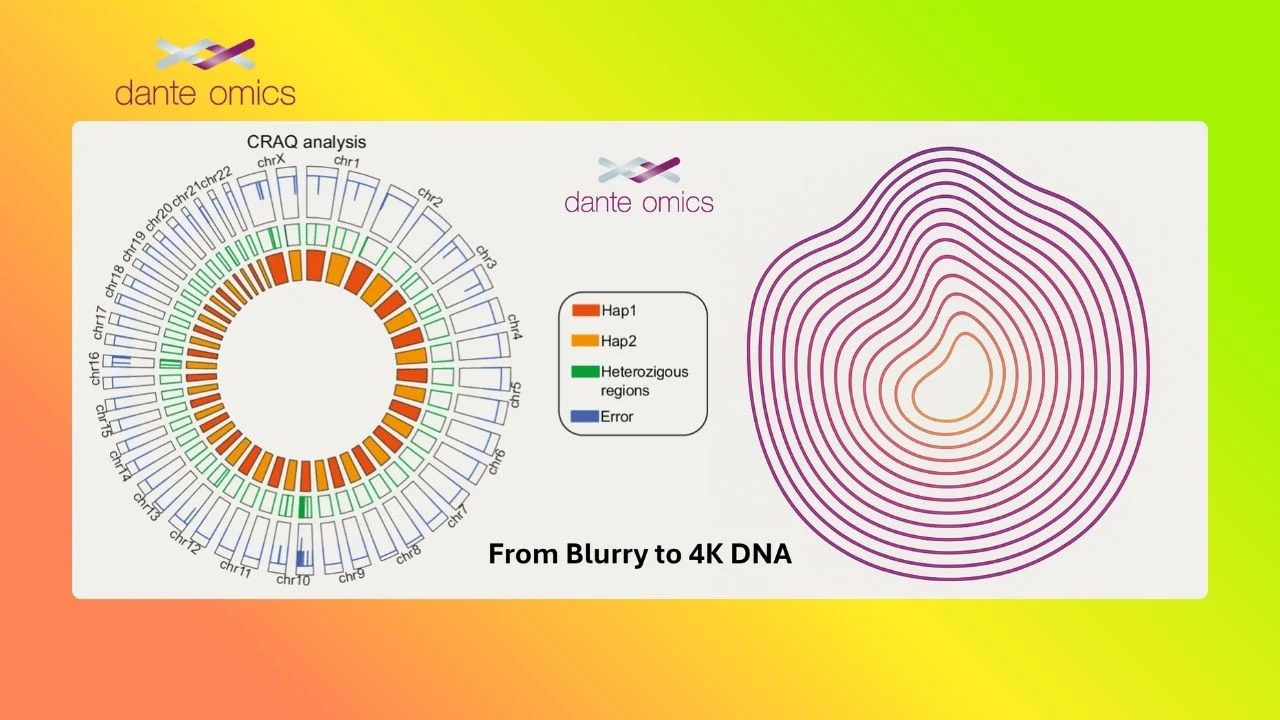Breakthrough in Genomics: Near-Complete Diploid Genome Assembly for RPE-1 Cell Line Achieves 99.9999% Accuracy
In a landmark achievement for genomic research, Dante Omics AI, in collaboration with Rockefeller University, the Giunta Lab, Sapienza University, the University of Tennessee, Trieste Area Science Park, and the University of L’Aquila, has successfully assembled a near-complete human diploid reference genome for the widely used RPE-1 cell line. Published in Nature Communications, this breakthrough provides a high-accuracy blueprint of the RPE-1 genome, capturing both maternal and paternal DNA with unparalleled precision. This development is set to revolutionize studies on centromeres, gene editing, and cell engineering.
A Game-Changing Reference Genome
The RPE-1 cell line is one of the most utilized models in cellular and molecular biology, playing a pivotal role in genetics, cancer research, and drug development. Until now, researchers lacked a fully phased, high-quality reference genome for this critical cell line. The newly assembled RPE1v1.1 genome bridges this gap, offering a near-complete diploid assembly with 99.9999% base-level accuracy across multiple chromosomes.
“Imagine trying to debug software when the source code is missing critical lines,” says Andrea Riposati, CEO of Dante Omics AI. “Now we have a precise source code for RPE-1 cells—down to the most complex, previously hidden regions of DNA like centromeres. This new reference genome is a game changer for all biotech firms advancing cell engineering and CRISPR gene editing.”
By leveraging cutting-edge sequencing technologies, including PacBio HiFi long reads and Oxford Nanopore Technologies (ONT), the team achieved an unprecedented level of detail. The assembly spans telomere-to-telomere, including hard-to-resolve regions such as centromeres and translocated chromosomes. This breakthrough enables researchers to study these regions with greater clarity, unlocking new possibilities for understanding genetic diversity and disease mechanisms.
True Diploid Assembly: Capturing Both Haplotypes
One of the standout features of the RPE1v1.1 assembly is its ability to fully capture both maternal and paternal DNA—a true diploid representation. Using advanced phasing techniques, the team resolved haplotypes chromosome by chromosome, achieving remarkable completeness and accuracy. For instance, the assembly includes detailed maps of centromeric regions, which are often excluded from traditional genome assemblies due to their repetitive and complex nature.
This level of resolution is particularly significant for studying centromeres, the critical structures that ensure proper chromosome segregation during cell division. Errors in centromere function can lead to chromosomal instability, a hallmark of many cancers. By providing a detailed map of these regions, the RPE1v1.1 genome opens new avenues for investigating the role of centromeres in health and disease.
Collaboration and Innovation at Scale
The success of this project was made possible through a powerful collaboration between leading institutions and Dante Omics AI’s expertise in genome sequencing. Leveraging the Dante Labs genome sequencing test, the team combined short-read and long-read sequencing technologies to generate high-coverage data. Advanced computational tools, including Verkko and Hi-C scaffolding, were used to assemble and phase the genome with exceptional fidelity.
“We thank the Giunta Lab and our partners for this exciting project,” says Andrea Riposati. “This achievement would not have been possible without the dedication and expertise of our collaborators, who brought together diverse skills and resources to tackle one of genomics’ toughest challenges.”
Open Access for Global Research
To ensure maximum impact, the RPE1v1.1 assembly is publicly available through the National Center for Biotechnology Information (NCBI) and the UCSC Genome Browser. Researchers worldwide can now access this high-quality reference genome to advance their studies on RPE-1 cells, which are instrumental in experiments ranging from fundamental biology to translational medicine.
Implications for Biotechnology and Beyond
The publication of the RPE1v1.1 genome marks a turning point in genomic research. Its unprecedented accuracy and completeness provide a robust foundation for exploring genetic variation, epigenetic regulation, and functional genomics. For biotech companies, this resource accelerates advancements in CRISPR gene editing, synthetic biology, and personalized medicine.
Moreover, the methods developed for this project pave the way for similar efforts in other cell lines and organisms. As Andrea Riposati notes, “This is just the beginning. With the right tools and collaborations, we can build comprehensive reference genomes for every important cell line, driving innovation across the life sciences.”
Access the Full Study
The full paper detailing the RPE1v1.1 assembly is available in Nature Communications: https://www.nature.com/articles/s41467-025-62428-z.
For more information about Dante Omics AI and its contributions to genomic research, visit danteomics.com.
With this milestone, the scientific community is better equipped than ever to unravel the complexities of the human genome, paving the way for transformative discoveries in biology and medicine.
About Dante Omics AI
We are a leading provider of AI-powered genomics solutions, dedicated to accelerating discovery and improving patient outcomes through advanced computational biology tools. The company’s innovative platform combines cutting-edge artificial intelligence with high-performance computing to deliver transformative genomic analysis capabilities for research institutions, clinical laboratories, and biotechnology companies worldwide.







